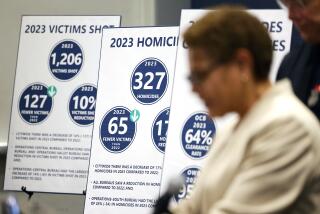Homicides Plunge in Manhattan, Rest of New York
- Share via
NEW YORK — Reflecting innovative law enforcement programs, the number of people slain in Manhattan dropped to 82 in 2002 -- the lowest in more than a century.
The number of homicides in Manhattan peaked in 1972 with 661 reported; in 2001, there were 102.
Citywide, homicides totaled 575 as of Sunday night, the first time the number has dropped below 600 since 1963, when 548 people were killed, according to Police Department statistics.
The decline comes at a time when the murder rate has begun to climb in some major cities, including Los Angeles, where it is up 10% over 2001. The rate rose by 3.1% nationwide in 2001, the first increase in a decade.
Mayor Michael R. Bloomberg and Police Commissioner Raymond Kelly praised the city’s police officers for the lower numbers.
“It’s a remarkable achievement. The credit goes to the men and women of the department who are out there every day making New York the safest big city in America,” Michael O’Looney, the commissioner’s chief spokesman, said Tuesday.
Officials said pressure on drug gangs, focus on quality-of-life offenses such as vandalism and drinking in public, and the ability to quickly identify and respond to crime trends were major factors contributing to the decline not only in Manhattan but throughout the city of 8 million.
“It is because of all the initiatives launched by the NYPD, the federal government and the Manhattan district attorney,” said Thomas Reppetto, head of the nonprofit Citizens Crime Commission. “There has been initiative after initiative.”
To a large extent, the Bloomberg administration has continued law enforcement programs begun by predecessor Rudolph W. Giuliani -- as Bloomberg has readily acknowledged.
The ability to track crime patterns quickly through computer-generated statistical analysis has allowed police to shift personnel promptly to neighborhoods where incidents are occurring and to hold local commanders accountable.
Before the sophisticated computer programs were installed, it often took weeks, sometimes months, before crime trends were identified.
Emphasis was placed both on making arrests for low-level offenses to create a climate of safety on the streets and reducing a huge backlog of fugitive warrants.
In the Washington Heights section of Upper Manhattan, where at one time drug gangs were highly visible, 119 homicides were recorded in 1991. Only 11 homicides had been reported in the area in 2002.
“The bulk of the murders that were occurring were the result of disputes among drug gangs,” Reppetto said. “The first activity was to get the drug gangs off the streets.
“They were shooting guns on the streets every night, sometimes spraying corners with automatic weapons and hitting nine or 10 people,” he added. “You had little kids sleeping in bathtubs, because their parents were afraid bullets would come through the windows.”
Reppetto and police officials said the innovative programs also led to declines in 2002 year in the city in robberies, assaults, burglaries, grand larcenies and auto thefts.
More to Read
Sign up for Essential California
The most important California stories and recommendations in your inbox every morning.
You may occasionally receive promotional content from the Los Angeles Times.










